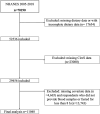Association of composite dietary antioxidant index with circadian syndrome: evidence from NHANES
- PMID: 39830063
- PMCID: PMC11740098
- DOI: 10.3389/fnut.2024.1501352
Association of composite dietary antioxidant index with circadian syndrome: evidence from NHANES
Abstract
Background: The Circadian Syndrome (CircS) has been linked to various chronic diseases. However, the relationship between composite dietary antioxidant index (CDAI) and CircS has remained unexplored. This study aimed to investigate the potential association between CDAI and CircS.
Methods: Cross-sectional analyses were based on the National Health and Nutrition Examination Survey (NHANES) 2005-2018. Dietary consumption was assessed via the 24-h diet recall method and CDAI was computed following a validated approach involving six antioxidants. CircS was defined based on metabolic syndrome components, supplemented by short sleep duration and depressive symptoms. The relationship between CDAI and CircS was examined using weighted multivariable logistic regression and subgroup analyses. Additionally, restricted cubic spline (RCS) regression was employed to investigate potential nonlinear correlations.
Results: Among 11,048 subjects included (mean age 47.57 years), 2,733 (weighted prevalence = 22.13%) were reported to have CircS. Logistic regression revealed that the highest quartile of CDAI was inversely associated with the risk of CircS {odds ratio (OR) [95% CI = 0.69 (0.55-0.87)]} and the risk of depression [OR = 0.59 (0.48-0.72)], short sleep duration [OR = 0.54 (0.41-0.70)], elevated fasting glucose [OR = 0.80 (0.65-0.98)], elevated triglycerides (TG) [OR = 0.74 (0.59-0.92)], elevated waist circumference [OR = 0.65, (0.52-0.80)] and reduced high-density lipoprotein cholesterol (HDL-C) [OR = 0.75 (0.61-0.92)], respectively. A dose-response gradient in odds of CircS components was noted as CDAI levels increased, particularly with depression and short sleep duration. RCS showed a non-linear relationship between CDAI and CircS, with a U-shaped correlation found between Zinc and CircS (inflection point 12.63). Subgroup analysis showed BMI modified the inverse association between CDAI and CircS (p for interaction = 0.003).
Conclusion: This study revealed a non-linear and negative association between CDAI and CircS risk, with a U-shaped correlation observed between Zinc and CircS. Obese individuals might not benefit from excessively high CDAI. The results suggest that a higher CDAI score was correlated with a decreased risk of CircS.
Keywords: NHANES; circadian syndrome; composite dietary antioxidant index; cross-sectional study; dietary antioxidant; restricted cubic spline.
Copyright © 2025 Chen, Zhao, Jin, Jiang, Wang and Li.
Conflict of interest statement
The authors declare that the research was conducted in the absence of any commercial or financial relationships that could be construed as a potential conflict of interest.
Figures






References
LinkOut - more resources
Full Text Sources
Miscellaneous

